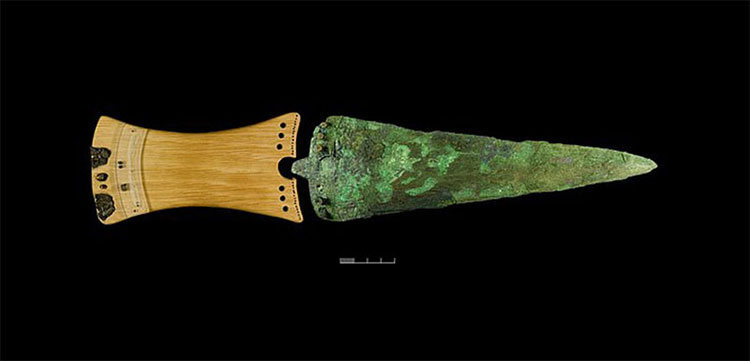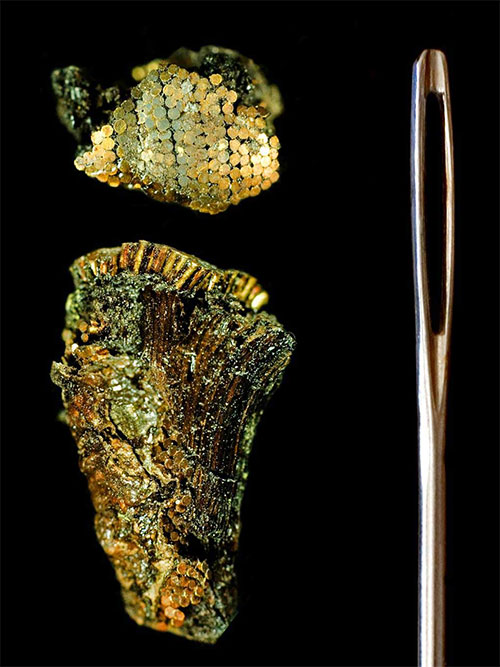4,000-year-old dagger knife attaches more than 140,000 gold beads
Ancient daggers discovered in England confuse the scientific community because the grip is so small that gold particles are so small that the eyes are often hard to see.
Christopher Standish, Ph.D. at the University of Southampton, is conducting an analysis to find out the gold on the dagger Bush Barrow , Express Digest, on June 22 reported. This Bronze-edged knife was found in the burial place of a chief near Stonehenge, England, in 1808. A few hours after being dug up and exposed to the air, the hilt began to decay gradually, only Gold beads encrusted on it are relatively intact.

Dagger Bush Barrow with the grip part rebuilt.(Photo: University of Birmingham).
Scientists have long wondered about the complexity of decorating the hilt by hand. It is attached to more than 140,000 gold particles , so small that it is almost invisible to the naked eye, each 1mm thick particle with a diameter of only 1 / 3mm. Gold beads are attached to the opaque holes made of sap, in a zigzag fashion with incredible density, 1,000 grains per cm 2 .
Experts say that only children 10 years and under are able to do such sophisticated work. Eye strain to look at too small details can be expensive, making eyesight plummet.
Christopher Standish wants to find out exactly the source of the gold particles. The particle will be scanned for X-rays to analyze the small amount of lead mixed in gold, thereby revealing some of the origin. Maybe this gold comes from Cornwall, Wales, Ireland or Brittany. Research results are expected to be published in November.

The grip part attaches tiny gold particles next to a needle.(Photo: University of Birmingham).
The blade and the rest of the hilt were displayed at the Wiltshire Museum in Devizes, England."This particular gold dagger is one of the most impressive prehistoric artifacts, but we don't know where and where it was made," said museum director David Dawson.
"There are other daggers with gold grips made at the same time, of which six were found in the UK and 22 were in Brittany. The English knives are not worth it. Brittany knives are quite good but none of them look like knives. darling Bush Barrow, it is most likely from France " , he added.
Dawson said that only those who are nearsighted can do the work that needs to be observed closely and meticulously."There must be Bronze-era metalmakers who are nearsighted when they grow up. They only look a few inches or more away. They cannot do anything other than make small objects and need help. from the community, " he said.
Experts estimate it takes at least 2,500 hours to complete the knife with 6 stages. First, gold must be rolled into a thin thread like human hair, a flattened end to create a round face for gold beads. The wire will be cut with a thin blade. The goldsmith uses a tiny puncher to punch holes in the wooden grip, then apply the plastic to it. Finally, they took tiny tweezers to attach the gold particles.
- Discovered 5,000-year-old gold dagger
- Close-up of the deadly dagger was banned in the United States
- Suddenly found a 4000-year-old dagger in Slovakia
- The reason King Tut invented a gold-studded dagger with meteors
- Top 10 most dangerous military knives
- Use knives every day, but are you sure you know all the benefits of each?
- King Tut's golden dagger was made from meteorite
- Gold leaf helps to charge the phone by folding the finger
- Video: How does a knife maker's day take place?
- Summary of the best news of the week 04/04/2017
- NASA makes super durable, self-sharpening knives for under $ 100
- The smart necklace keeps track of recollections
 Discovered an ancient centipede fossil 99 million years old
Discovered an ancient centipede fossil 99 million years old Discovered bat-like dinosaurs in China
Discovered bat-like dinosaurs in China Discovered a 200-year-old bronze cannon of the coast
Discovered a 200-year-old bronze cannon of the coast Discover 305 million-year-old spider fossils
Discover 305 million-year-old spider fossils